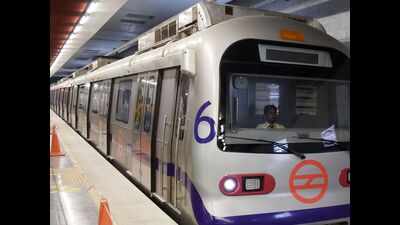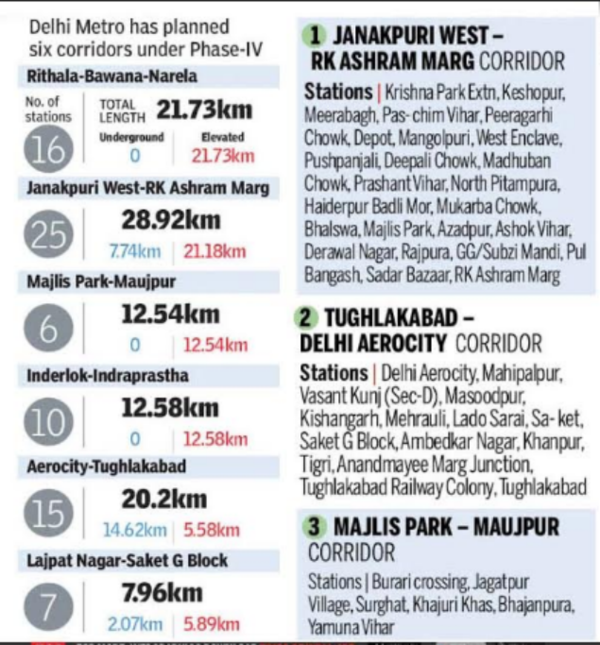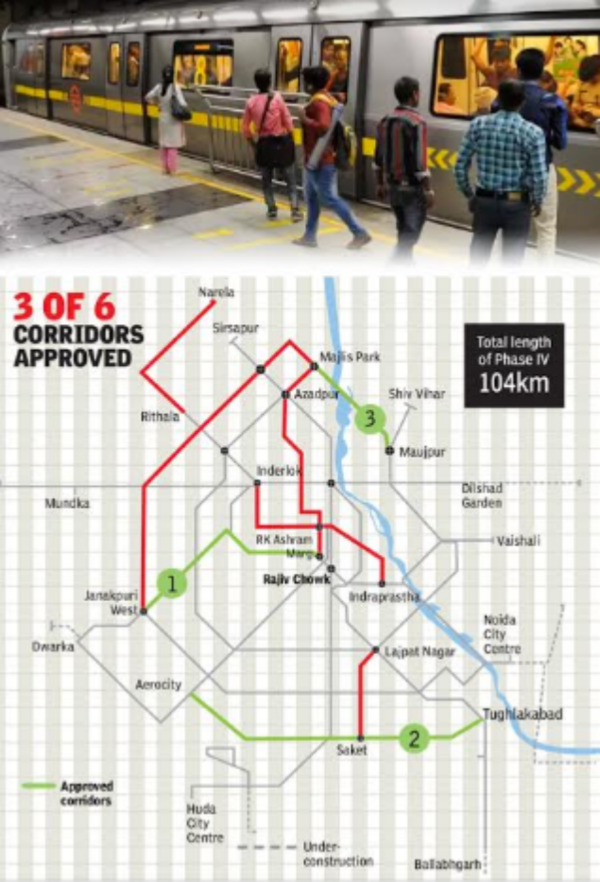- News
- City News
- delhi News
- Vasant Kunj on track, far-flung areas to be linked
Trending
This story is from March 8, 2019
Vasant Kunj on track, far-flung areas to be linked
With the Union cabinet approving three corridors of Delhi Metro’s Phase IV project on Thursday, a number of south Delhi localities will come closer to the Indira Gandhi International airport. Also, Vasant Kunj will appear on the metro map for the first time.

Representative image
NEW DELHI: With the Union cabinet approving three corridors of Delhi Metro’s Phase IV project on Thursday, a number of south Delhi localities will come closer to the Indira Gandhi International airport. Also, Vasant Kunj will appear on the metro map for the first time.

The Tughlaqabad-Delhi Aerocity Line, one of three corridors to get the cabinet approval on Thursday, will shorten the distance from south Delhi to IGI to up to 15 minutes.

The other two corridors are the Janakpuri West-RK Ashram Marg Line, which will be the longest in the Phase IV project and will connect southwest Delhi to north and central Delhi, and the Maujpur-Mukundpur corridor, which is expected to bring much-needed metro connectivity to northeast Delhi.
The over 20km-long Tughlaqabad-Delhi Aerocity corridor will have 15 stations, with both the terminal stations acting as interchange points with the Violet Line and Airport Express Line, respectively. The corridor will not only bring Delhi airport closer to many south Delhi, but will also put a number of south Delhi localities on the metro map for the first time.
Vasant Kunj’s Sector D, which suffers from an acute lack of public transport, will get a metro station. The corridor will also put heavily populated areas like Mahipalpur, Kishangarh, Ambedkar Nagar and Khanpur on the metro map. Areas such as Mehrauli, Lado Sarai and Saket, which already have metro stations or are located near metro corridors, will have improved connectivity once the corridor is completed.
The longest corridor of Phase IV project — Janakpuri West-RK Ashram Marg (29km) — will provide direct connectivity among west, northwest and north Delhi before terminating in central Delhi. With 25 stations, the corridor will start from Janakpuri West station, which is already an interchange station with the Blue Line (Dwarka-Vaishali/Noida City Centre) and Magenta Line (Janakpuri West-Botanical Garden) meeting here.
Janakpuri West-RK Ashram Marg corridor will also cross the Green Line (Inderlok-City Park) at Peeragarhi and the Pink Line twice at Majlis Park and Azadpur. It will also cross the Red (Dilshad Garden-Rithala) and Yellow lines (HUDA City Centre-Samaypur Badli) twice at Pitampura and Pul Bangash and Haiderpur Badli Mor and Azadpur, respectively, before terminating at RK Ashram Marg station on Blue Line. At nine stations, this corridor will have the highest number of interchange points in Phase IV.
The Majlis Park-Maujpur corridor, meanwhile, will have six stations with both terminal stations coming up as interchange stations. This small corridor will serve as a vital link between north and northeast Delhi. It will bring heavily populated areas of northeast Delhi, such as Burari, Jagatpur, Surghat, Khajuri Khas, Bhajan Pura and Yamuna Vihar, on the metro map for the first time.
While Phase I saw the eastern part of the city getting connected to west and north Delhi with New Delhi, Phase II witnessed the corridors extending further, touching the southern part of Delhi and entering NCR for the first time.
However, the first two phases of Delhi Metro’s expansion mostly saw linear growth with radial lines reaching all corners of Delhi-NCR. Phase III witnessed these radials getting connected by new corridors like Pink and Magenta lines, which are in the shape of concentric circles. Delhi Metro’s Phase IV, work on which is expected to begin soon, will further bolster the network by reaching far flung areas of northeast Delhi and improving connectivity in south and central Delhi.

The Tughlaqabad-Delhi Aerocity Line, one of three corridors to get the cabinet approval on Thursday, will shorten the distance from south Delhi to IGI to up to 15 minutes.

Work on the three corridors is expected to start soon and metro sources said it would take 3-4 years to complete.
The other two corridors are the Janakpuri West-RK Ashram Marg Line, which will be the longest in the Phase IV project and will connect southwest Delhi to north and central Delhi, and the Maujpur-Mukundpur corridor, which is expected to bring much-needed metro connectivity to northeast Delhi.
The over 20km-long Tughlaqabad-Delhi Aerocity corridor will have 15 stations, with both the terminal stations acting as interchange points with the Violet Line and Airport Express Line, respectively. The corridor will not only bring Delhi airport closer to many south Delhi, but will also put a number of south Delhi localities on the metro map for the first time.
Vasant Kunj’s Sector D, which suffers from an acute lack of public transport, will get a metro station. The corridor will also put heavily populated areas like Mahipalpur, Kishangarh, Ambedkar Nagar and Khanpur on the metro map. Areas such as Mehrauli, Lado Sarai and Saket, which already have metro stations or are located near metro corridors, will have improved connectivity once the corridor is completed.
The longest corridor of Phase IV project — Janakpuri West-RK Ashram Marg (29km) — will provide direct connectivity among west, northwest and north Delhi before terminating in central Delhi. With 25 stations, the corridor will start from Janakpuri West station, which is already an interchange station with the Blue Line (Dwarka-Vaishali/Noida City Centre) and Magenta Line (Janakpuri West-Botanical Garden) meeting here.
Janakpuri West-RK Ashram Marg corridor will also cross the Green Line (Inderlok-City Park) at Peeragarhi and the Pink Line twice at Majlis Park and Azadpur. It will also cross the Red (Dilshad Garden-Rithala) and Yellow lines (HUDA City Centre-Samaypur Badli) twice at Pitampura and Pul Bangash and Haiderpur Badli Mor and Azadpur, respectively, before terminating at RK Ashram Marg station on Blue Line. At nine stations, this corridor will have the highest number of interchange points in Phase IV.
The Majlis Park-Maujpur corridor, meanwhile, will have six stations with both terminal stations coming up as interchange stations. This small corridor will serve as a vital link between north and northeast Delhi. It will bring heavily populated areas of northeast Delhi, such as Burari, Jagatpur, Surghat, Khajuri Khas, Bhajan Pura and Yamuna Vihar, on the metro map for the first time.
While Phase I saw the eastern part of the city getting connected to west and north Delhi with New Delhi, Phase II witnessed the corridors extending further, touching the southern part of Delhi and entering NCR for the first time.
However, the first two phases of Delhi Metro’s expansion mostly saw linear growth with radial lines reaching all corners of Delhi-NCR. Phase III witnessed these radials getting connected by new corridors like Pink and Magenta lines, which are in the shape of concentric circles. Delhi Metro’s Phase IV, work on which is expected to begin soon, will further bolster the network by reaching far flung areas of northeast Delhi and improving connectivity in south and central Delhi.
End of Article
FOLLOW US ON SOCIAL MEDIA










